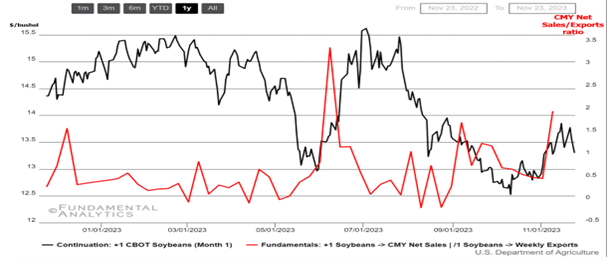November 27, 2023
US agriculture futures continue to trade under oversupply expectations from key producers and dollar depreciation.
Wheat
Wheat below $5.5 as global supply hits the market

- Even with a weaker dollar, US wheat prices continue its downside trend as plentiful global supplies kept prices for U.S. wheat uncompetitive.
- U.S. wheat futures also struggled as export volumes continue to dip to some of the lowest levels since the 1970s.
- Moreover, steady shipping volumes out of Russia and Ukraine continue to dominate the market. Dry weather in Australia has reduced the country’s total wheat haul for this year, but timely rains and cooler weather have helped improve quality ratings for the Australian crop.
- The USDA upwardly revised its forecast on Russia’s total wheat production to 90 million tons in the current marketing year, 2 million tons away from last year’s record high, and supporting exports in the period at a record-high 50 million tons.
- Higher-than-expected precipitation in Argentina also boosted production expectations from key grain producers in the country, adding to global supply.
Corn
Corn futures under downward pressure

- Corn futures in the US dropped below $4.7 per bushel, the lowest in nearly 3 years amid record supply prospects.
- Furthermore, worries about end usage from the ethanol complex also kept corn trading in the red.
- Export sales in the weekly USDA report found corn sales coming in on the high end of pre-report analyst expectations at 56.4 million bushels.
- USDA report expects that higher 2023/2024 US corn yields will boost total feed grain supply.
Soybeans
Increased volatility in soybeans futures

- Soybean futures traded lower than $13.5 per bushel mark, below a 2 1/2-month high of $14 reached in mid-November as rains in Brazil alleviated concerns about unfavorable dryness.
- Despite weather challenges, agriculture analysts anticipate Brazil’s soybean crop to reach a record 161.6 million metric tons in the 2023/24 season.
- In Argentina, another significant producer, the grains trade is facing significant challenges as it is largely “paralyzed” due to a shortage of soybeans caused by drought. Farmers are holding onto their produce amid expectations of a peso devaluation under President-elect Javier Milei.
- On the demand side, China’s ongoing appetite for grains is helping support soybean demand.